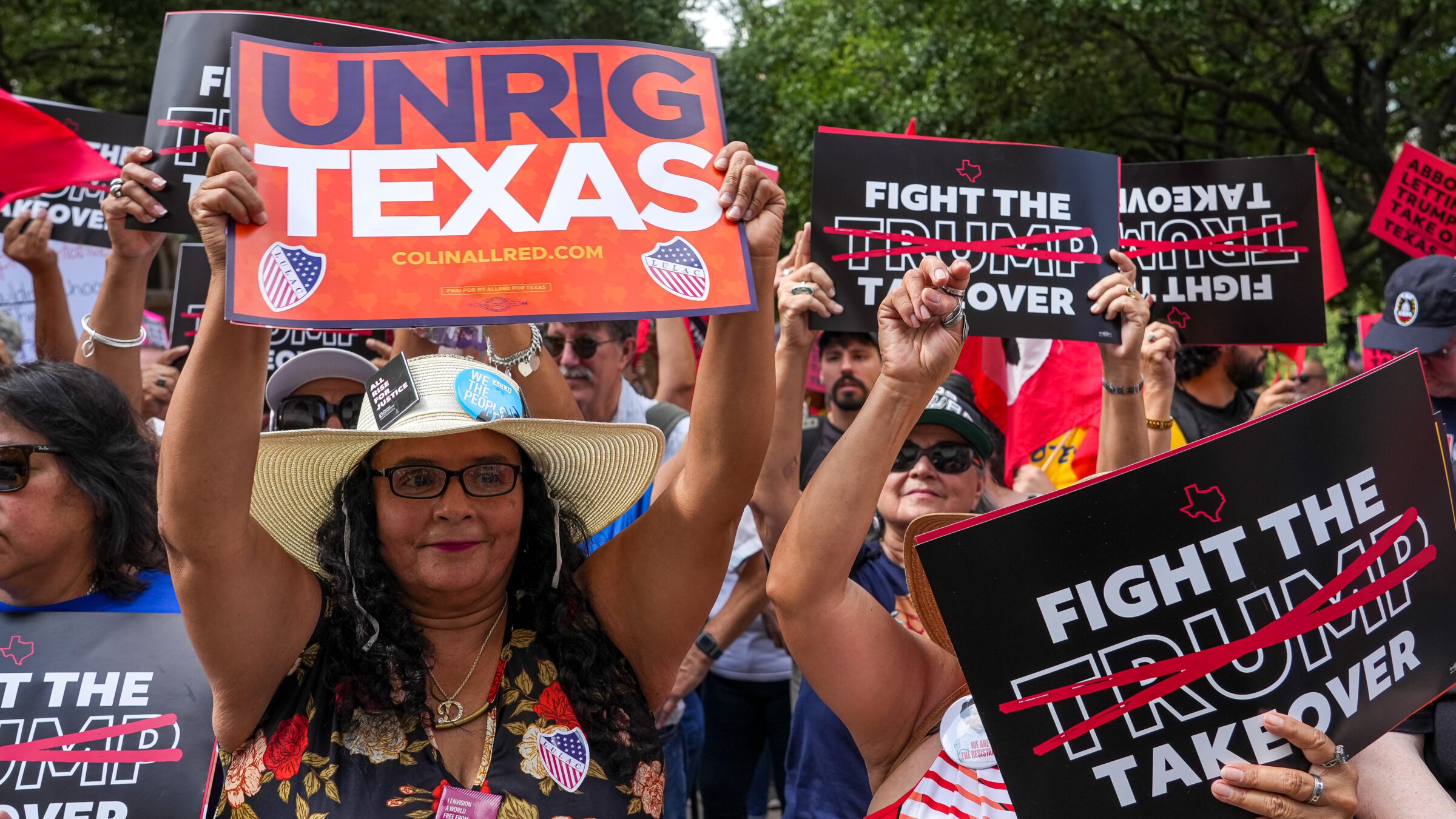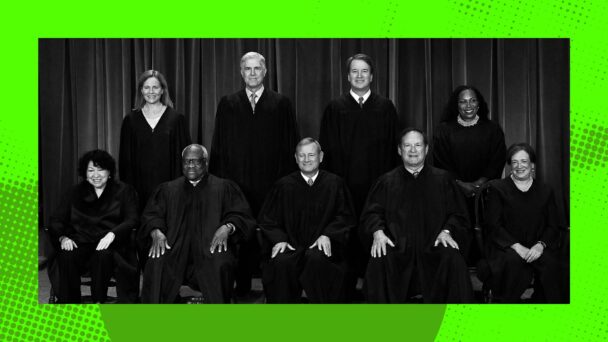The technical questions in Louisiana v. Callais, which the Supreme Court will decide sometime next year, sound mostly like gibberish to people who are not already intimately familiar with several decades’ worth of Voting Rights Act jurisprudence. At oral argument earlier this month, the justices spent most of their time pondering the propriety of evaluating allegedly gerrymandered maps using the three “Gingles preconditions,” which should not be confused with the nine “Senate factors,” let alone the “totality of the circumstances” standard that judges presiding over these cases are supposed to apply when weighing the evidence.
Beyond the four walls of the Supreme Court, however, Republican elected officials are already giddy about the result they expect in Callais: a decision that consigns what is left of the Voting Rights Act to the dustbin of history, thus freeing up Republicans across the country to gerrymander Black people out of electoral existence.
Callais is about Section 2 of the Voting Rights Act, which generally prohibits voting laws that discriminate based on race. But for decades, the Court has distinguished between laws that discriminate based on race and laws that are designed to remediate racial discrimination, on the grounds that decisionmakers must be able to take race into account in order to effectively implement a law that addresses this country’s enduring legacy of racism. This exception is what allows Republican legislatures in Southern states where voting is racially polarized to (begrudgingly, usually under court order) create majority-minority districts, thus ensuring that members of minority groups have a fair shot at electing representatives of their choice.
In Callais, Louisiana Republicans—with the enthusiastic support of the Trump administration and just about every other conservative interest group you can imagine—are challenging this precedent. They want the Court’s six-justice conservative supermajority to hold that legislatures can’t create majority-minority districts in order to comply with the Voting Rights Act, because doing so “discriminates” based on race in violation of the Equal Protection Clause of the Fourteenth Amendment.
The Court could issue its opinion in Callais anytime between now and July, but as Politico reports, Republican politicians are already planning the victory parade route. In South Carolina, party officials are fantasizing about drawing a new map to eliminate the seat of Democratic Congressman Jim Clyburn, the state’s only Black House member, and hand a “clean sweep” to the GOP. In Louisiana, Governor Jeff Landry led an effort to reschedule the state’s 2026 primaries, to give lawmakers extra time to draw maps that will maximize their chances of success in the general election. In Florida, where Republicans already enjoy a 20-8 electoral district advantage, Governor Ron DeSantis has signaled his interest in rejiggering the southern portion of the state to get rid of some of the majority-minority districts that he hopes Callais will soon render unconstitutional.
Back in 2010, Florida voters approved a ballot measure to prohibit partisan gerrymandering and to enshrine additional protections for minority voters in the state constitution, which could complicate DeSantis’s task somewhat. But as Politico points out, legal challenges to any new map would ultimately be decided by the seven justices of the Florida Supreme Court, all of whom are Republican appointees, and five of whom were put there by DeSantis himself. Earlier this year, the Florida Supreme Court upheld a Republican-drawn map that got rid of a congressional district represented by a Black Democrat on the grounds that, in the court’s view, that district was an illegal racial gerrymander in favor of Black people. What I am saying here is that whatever the Florida Constitution says, I am not sure that the Republican lawyers who eventually have to defend an even more pro-Republican map will have much to worry about.

Rallygoers protest proposed mid-decade redistricting efforts in Texas, August 2025 (Aaron E. Martinez/Austin American-Statesman via Getty Images)
The anticipated wave of post-Callais pro-Republican redistricting in these states should not be confused with ongoing pro-Republican redistricting efforts in Missouri, North Carolina, and Texas, where President Donald Trump has been urging his allies to do everything within their power to keep the House under Republican control. Typically, states redraw their maps every ten years, using the results of each decennial census. But since the Republican Party’s official policy platform in all things is Do Whatever Mister Trump Asks As Soon as Possible, lawmakers in several key states are trying to carve out a few more safe red seats in time for the 2026 midterms. In August, Texas Governor Greg Abbott signed off on a modified map that targets five Democratic House seats. In North Carolina, where Republicans already hold 10 of 14 congressional seats, GOP lawmakers are trying to stretch their advantage to 11 to 3.
In Missouri, Governor Mike Kehoe recently signed off on a “Missouri First” map that would dismantle one of two safe Democratic seats in the state, citing his putative duty to ensure that “Missouri’s conservative, common-sense values” are “truly represented at all levels of government.” Activists are working to add to the ballot a referendum that will allow voters the opportunity to overrule their elected representatives, but if the map were to take effect, Republicans are all but guaranteed to pick up an additional House seat.
In any other year, Democrats could expect to make significant gains in 2026, since the party that does not hold the White House tends to do better in the midterms immediately following each presidential contest. Since Republicans currently only hold a 219-214 edge in the House, it’s not out of the question that, in the midst of a historically unpopular presidential administration that is both metaphorically and literally taking a wrecking ball to American democracy, Democrats could take back the gavel in decisive fashion next year.
Alas, a year in which the Court could at any moment issue an opinion scuttling the heart of the Voting Rights Act does not qualify as “normal.” When combined with Republicans’ ongoing Trump-induced efforts to entrench themselves in power, a ruling in Callais that strikes down majority-minority districts as the products of illegal anti-white discrimination could not only preserve the existing Republican House majority in 2026, but also increase it—according to one study, by anywhere from 19 to 27 seats. As hard as the president might be working to rig the maps in his favor, at this moment, there is no Republican politician who has as much power to advance his party’s agenda than Chief Justice John Roberts.
In public, Supreme Court justices often insist that they merely interpret and apply the law, and that things like politics and partisanship play no role in their work. This is always wrong, but it is never more wrong than when elected officials from the same party that controls the Court are already openly celebrating a new era in which they will at last be free of their pesky legal obligations to allow people of color to participate in democracy. What Republicans understand is that the freer and fairer an election is, the more challenging that election is for them to win. The justices might soon ensure that they have one less thing to worry about.






